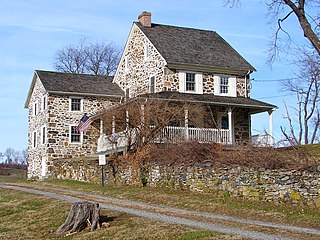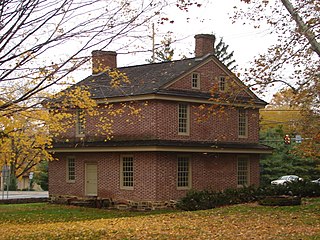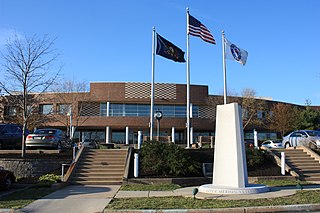
Willistown Township is a township in Chester County, Pennsylvania, United States. The population was 10,497 at the 2010 census. At the 1860 census, the population of Willistown was 1,521, and in 1980 it was 8,269.

Newtown Township, also referred to by the name of its post office of Newtown Square, is a township in Delaware County, Pennsylvania, United States. Prior to 1789, it was part of Chester County. As of the 2020 census, the population was 15,002.

Upper Merion Township is a township in Montgomery County, Pennsylvania, United States. The population was 33,613 at the 2020 U.S. Census. Located 16 miles (26 km) from Philadelphia, it consists of the villages of Gulph Mills, King of Prussia, Swedeland, Swedesburg, and portions of Radnor, and Wayne.

Wyncote is a census-designated place (CDP) in Cheltenham Township, Montgomery County, Pennsylvania, United States. It borders the northwestern and northeastern section of Philadelphia. Wyncote is located 11 miles from Center City Philadelphia at the southeasternmost tip of Montgomery County. The Jenkintown-Wyncote SEPTA station is the fifth busiest regional rail station in the SEPTA system.

Radnor Township, often called simply Radnor, is a first class township with home rule status in Delaware County, Pennsylvania, United States.

Radnor is a community which straddles Montgomery and Delaware Counties, Pennsylvania, United States. It is located approximately 13 miles west of Philadelphia, in the Main Line suburbs. The community was named after Radnor, in Wales.

Wayne is an unincorporated community centered in Delaware County, Pennsylvania, United States, on the Main Line, a series of highly affluent Philadelphia suburbs located along the railroad tracks of the Pennsylvania Railroad and one of the wealthiest areas in the nation. While the center of Wayne is in Radnor Township, Wayne extends into both Tredyffrin Township in Chester County and Upper Merion Township in Montgomery County. The center of Wayne was designated the Downtown Wayne Historic District in 2012. Considering the large area served by the Wayne post office, the community may extend slightly into Easttown Township, Chester County, as well.

Rosemont is a neighborhood and census-designated place that is located in Pennsylvania, United States on the Philadelphia Main Line. Partly in Lower Merion Township in Montgomery County and partly in Radnor Township in Delaware County, it is best known as the home of Rosemont College. It is the location of the 1894 gothic-revival Anglo-Catholic Church of the Good Shepherd.

Pennsbury Manor is the colonial estate of William Penn, founder and proprietor of the Colony of Pennsylvania, who lived there from 1699 to 1701. He left it and returned to England in 1701, where he died penniless in 1718. Following his departure and financial woes, the estate fell into numerous hands and disrepair. Since 1939 it has been the name of a reconstructed manor on the original property.

Theophilus Parsons Chandler Jr. was an American architect of the late 19th and early 20th centuries. He spent his career at Philadelphia, and is best remembered for his churches and country houses. He founded the Department of Architecture at the University of Pennsylvania (1890), and served as its first head.

St. David's Episcopal Church, also known as St. David's at Radnor or Old St. David's, is a parish of the Episcopal Church located at 763 South Valley Forge Road in Radnor Township, Pennsylvania. The church property contains the original church built in 1715, a chapel, church offices, school and cemetery. The property straddles the borders of Radnor Township and Newtown Township in Delaware County and the majority of the cemetery is in Easttown Township, Chester County. It was founded c. 1700 in the Welsh Tract section of the Province of Pennsylvania by Welsh settlers and has grown to be the largest congregation in the Episcopal Diocese of Pennsylvania with approximately 3,000 members. The original church and cemetery were placed on the National Register of Historic Places in 1978.

The Radnor Friends Meetinghouse is an historic, American Quaker meeting house that is located on Sproul and Conestoga Roads in Radnor Township, Delaware County, Pennsylvania.

Herman Louis Duhring Jr. was an American architect from Philadelphia, Pennsylvania. He designed several buildings that are listed on the U.S. National Register of Historic Places.

Glen Foerd is a historic mansion and estate located in the Torresdale neighborhood of Philadelphia, Pennsylvania, overlooking the Delaware River near the mouth of Poquessing Creek.
Furness & Evans was a Philadelphia architectural partnership, established in 1881, between architect Frank Furness and his former chief draftsman, Allen Evans. In 1886, other employees were made partners, and the firm became Furness, Evans & Company. George Howe worked in the firm and later became a partner at Mellor & Meigs, another Philadelphia firm.

The White Horse Historic District, also known as White Horse Village, is a national historic district that is located in Willistown Township, Chester County, Pennsylvania.

The Reading Furnace Historic District is a national historic district that is located in Warwick Township and East Nantmeal Township, Chester County, Pennsylvania.
Bolingbroke Mansion is an 18th-century mansion located in Radnor, Pennsylvania, now used as a party house.





















